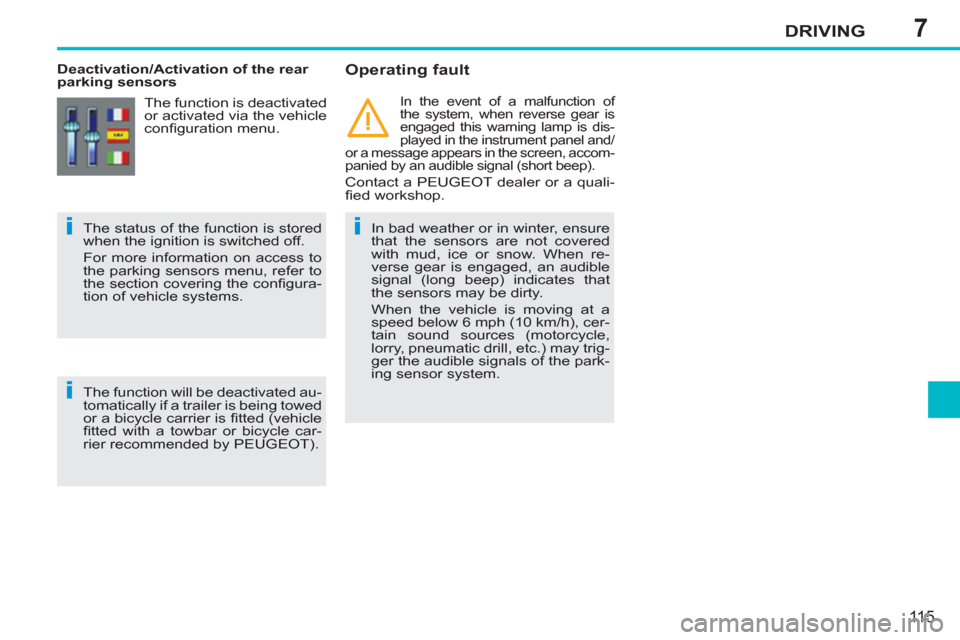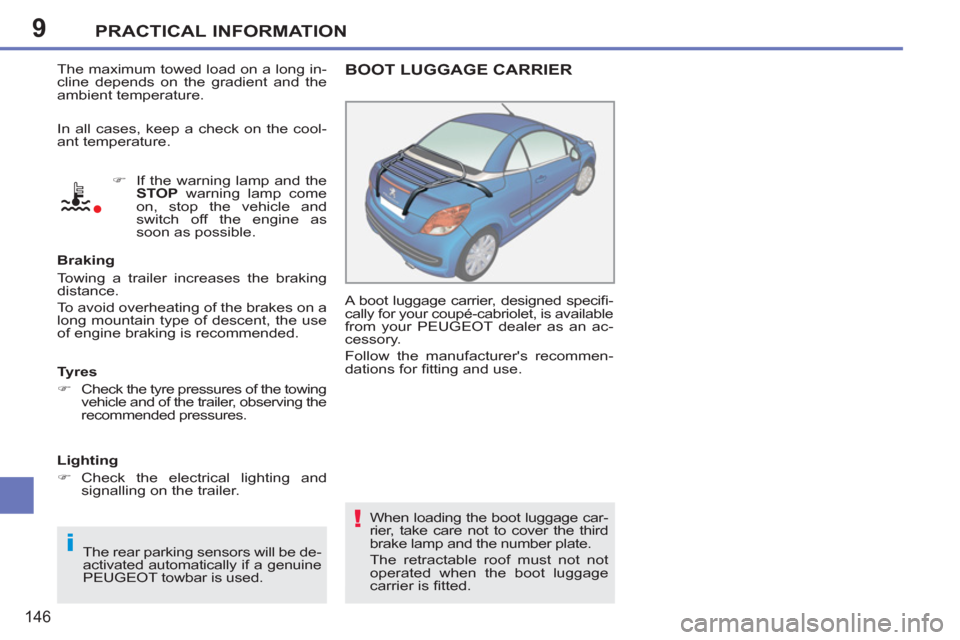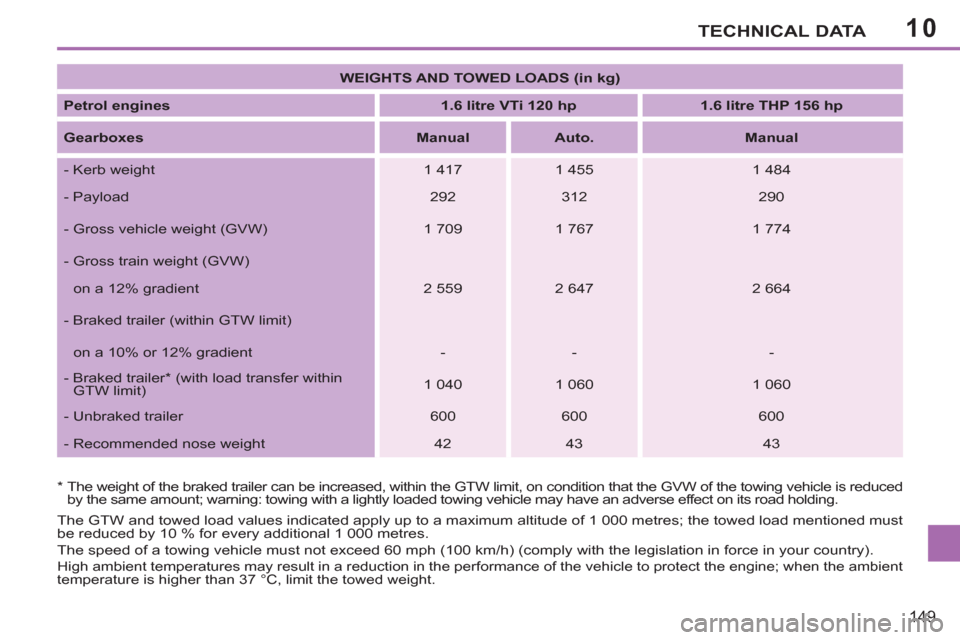2012 Peugeot 207 CC trailer
[x] Cancel search: trailerPage 5 of 224

3
CONTENTS
Direction indicators 93
Emergency or assistance
call 93
Hazard warning lamps 94
Horn 94
Tyre under-infl ation detection 95
Braking assistance
systems 96
Trajectory control
systems 97
Seat belts 98
Airbags 101■
■
■
■
■
■
■
■
■
SAFETY 93 �Π104
Parking brake 105
Manual gearbox 105
Gear shift indicator 106
Automatic gearbox 107
Speed limiter 110
Cruise control 112
Parking sensors 114■
■
■
■
■
■
■
DRIVING 105 �Π11 5
Bonnet 117
Running out of fuel (Diesel) 117
Petrol engines 118
Diesel engine 119
Checking levels 120
Checks 121■
■
■
■
■
■
CHECKS
116 �Π122
Temporary puncture
repair kit 123
Changing a wheel 128
Changing a bulb 132
Changing a fuse 136
Battery 141
Energy economy mode 143
Changing a wiper blade 143
Towing the vehicle 144
Towing a trailer 145
Accessories 147■
■
■
■
■
■
■
■
■
■
PRACTICAL
INFORMATION 123 �Π147
Petrol engines 148
Weights (petrol) 149
Diesel engine 150
Weights (Diesel) 151
Dimensions 152
Identifi cation markings 153■
■
■
■
■
■
TECHNICAL
D ATA 148 �Π154
AUDIO EQUIPMENT
and TELEMATICS 155 �Π210
Emergency or assistance 155Peugeot Connect Navigation (RNEG) 157
Peugeot Connect Sound (RD5) 189■
■
■
ALPHABETICAL
INDEX 215 �Π218
7
86
9
10
VISUAL
SEARCH 211 �Π214
Page 21 of 224

19
Limit the causes of excess
consumption
Spread loads throughout the vehicle;
place the heaviest items in the bottom
of the boot, as close as possible to the
rear seats.
Limit the loads carried in the vehicle
and reduce wind resistance (roof bars,
roof rack, bicycle carrier, trailer...). Use
a roof box in preference.
Remove roof bars and roof racks after
use.
At the end of winter, remove snow
tyres and refi t your summer tyres.
Observe the recommendations
on maintenance
Check the tyre pressures regularly,
when cold, referring to the label in the
door aperture, driver’s side.
Carry out this check in particular:
- before a long journey,
- at each change of season,
- after a long period out of use.
Don’t forget the spare wheel and the
tyres on any trailer or caravan.
Have your vehicle serviced regularly
(engine oil, oil fi lter, air fi lter...) and ob-
serve the schedule of operations rec-
ommended by the manufacturer.
When refuelling, do not continue after
the 3 rd cut-off of the nozzle to avoid
any overfl ow.
At the wheel of your new vehicle,
it is only after the fi rst 1 800 miles
(3 000 kilometres) that you will see the
fuel consumption settle down to a con-
sistent average.
Page 117 of 224

7
ii
i
DRIVING
115
Deactivation/Activation of the rear
parking sensors
Operating fault
In bad weather or in winter, ensure
that the sensors are not covered
with mud, ice or snow. When re-
verse gear is engaged, an audible
signal (long beep) indicates that
the sensors may be dirty.
When the vehicle is moving at a
speed below 6 mph (10 km/h), cer-
tain sound sources (motorcycle,
lorry, pneumatic drill, etc.) may trig-
ger the audible signals of the park-
ing sensor system.
In the event of a malfunction of
the system, when reverse gear is
engaged this warning lamp is dis-
played in the instrument panel and/
or a message appears in the screen, accom-
panied by an audible signal (short beep).
Contact a PEUGEOT dealer or a quali-
fi ed workshop.
The status of the function is stored
when the ignition is switched off.
For more information on access to
the parking sensors menu, refer to
the section covering the confi gura-
tion of vehicle systems.
The function will be deactivated au-
tomatically if a trailer is being towed
or a bicycle carrier is fi tted (vehicle
fi tted with a towbar or bicycle car-
rier recommended by PEUGEOT).
The function is deactivated
or activated via the vehicle
confi guration menu.
Page 139 of 224

9PRACTICAL INFORMATION
137
Dashboard fuses
The fusebox is placed in the lower part
of the dashboard (left-hand side).
Access to the fuses
�)
refer to the "Access to the tools"
paragraph.
Fuse N°
Rating
Functions
G37
30 A
Retractable roof unit supply.
G38
20 A
Hi-Fi amplifi er.
G39
-
Not used.
G40
40 A
Trailer fuse box supply.
Fuse N°
Rating
Functions
F1
-
Not used.
F2
-
Not used.
F3
5 A
Airbags and pre-tensioners control unit.
F4
10 A
Clutch pedal switch, diagnostic socket,
electrochromatic interior mirror, air conditioning,
steering wheel angle sensor, particle emission fi lter
pump (Diesel).
F5
30 A
Rear electric windows, retractable roof.
F6
30 A
Front electric windows, folding mirrors supply.
F7
5 A
Front courtesy lamp, map reading lamps, sun visor
lighting, glove box lighting.
Fuse table
Page 140 of 224

9PRACTICAL INFORMATION
138
Fuse N°
Rating
Functions
F8
20 A
Audio/telephone, multifunction screen, steering
wheel controls, tyre under-infl ation detection, trailer
fusebox, alarm (accessory).
F9
30 A
Front 12 V socket, front courtesy lamp, map reading
lamps, sun visor lighting, glove box lighting.
F10
15 A
Alarm siren, alarm control unit, directional
headlamps.
F11
15 A
Diagnostic socket, low current ignition switch,
automatic gearbox control unit.
F12
15 A
Brightness sensor, trailer fusebox, retractable roof.
F13
5 A
Engine fusebox, ABS relay, dual-function brake
switch.
F14
15 A
Instrument panel, seat belt warning lamp panel, headlamp
adjustment, air conditioning, audio equipment, hands-free
kit, rear parking assistance control unit.
F15
30 A
Locking and deadlocking.
F17
40 A
Rear screen and exterior mirrors demist/defrost.
SH
-
PARC shunt.
Page 147 of 224

9
!
i
PRACTICAL INFORMATION
145
General recommendations
Observe the legislation in force in
your country.
Ensure that the weight of the tow-
ing vehicle is higher than that of the
towed vehicle.
The driver must stay at the wheel
of the towed vehicle.
Driving on motorways and fast
roads is prohibited when towing.
When towing a vehicle with all four
wheels on the ground, always use
an approved towing bar; rope and
straps are prohibited.
When towing a vehicle with the
engine off, there is no longer any
power assistance for braking or
steering.
In the following cases, you must al-
ways call on a professional recovery
service:
- vehicle broken down on a mo-
torway or fast road,
- when it is not possible to put the
gearbox into neutral, unlock the
steering, or release the parking
brake,
- towing with only two wheels on
the ground,
- where there is no approved
towing bar available...
TOWING A TRAILER
Your vehicle is primarily designed for
transporting people and luggage, but it
may also be used for towing a trailer. Driving with a trailer places greater de-
mands on the towing vehicle and the
driver must take particular care.
Distribution of loads
�)
Distribute the load in the trailer so
that the heaviest items are as close
as possible to the axle and the nose
weight approaches the maximum
permitted without exceeding it.
Air density decreases with altitude, thus
reducing engine performance. Above
1 000 metres, the maximum towed load
must be reduced by 10 % for every
1 000 metres of altitude.
Refer to the "Technical Data" section for
details of the weights and towed loads
which apply to your vehicle.
Side wind
�)
Take into account the increased
sensitivity to side wind.
Towbar suitable for the attachment of a
trailer with additional lighting and sig-
nalling.
We recommend the use of genuine
PEUGEOT towbars and their har-
nesses that have been tested and
approved from the design stage of
your vehicle, and that the fi tting of the
towbar is entrusted to a PEUGEOT
dealer or a qualifi ed workshop.
If the towbar is not fi tted by a PEUGEOT
dealer, it is imperative that it is fi tted in
accordance with the vehicle manufac-
turer's instructions.
Driving advice
Cooling
Towing a trailer on a slope increases
the temperature of the coolant.
As the fan is electrically controlled, its
cooling capacity is not dependent on
the engine speed.
�)
To lower the engine speed, reduce
your speed.
Page 148 of 224

9
i
!
PRACTICAL INFORMATION
146
The maximum towed load on a long in-
cline depends on the gradient and the
ambient temperature.
�)
If the warning lamp and the
STOP
warning lamp come
on, stop the vehicle and
switch off the engine as
soon as possible.
Braking
Towing a trailer increases the braking
distance.
To avoid overheating of the brakes on a
long mountain type of descent, the use
of engine braking is recommended.
Tyres
�)
Check the tyre pressures of the towing
vehicle and of the trailer, observing the
recommended pressures.
The rear parking sensors will be de-
activated automatically if a genuine
PEUGEOT towbar is used.
In all cases, keep a check on the cool-
ant temperature.
Lighting
�)
Check the electrical lighting and
signalling on the trailer. BOOT LUGGAGE CARRIER
A boot luggage carrier, designed specifi -
cally for your coupé-cabriolet, is available
from your PEUGEOT dealer as an ac-
cessory.
Follow the manufacturer's recommen-
dations for fi tting and use.
When loading the boot luggage car-
rier, take care not to cover the third
brake lamp and the number plate.
The retractable roof must not not
operated when the boot luggage
carrier is fi tted.
Page 151 of 224

10TECHNICAL DATA
149
The GTW and towed load values indicated apply up to a maximum altitude of 1 000 metres; the towed load mentioned must
be reduced by 10 % for every additional 1 000 metres.
The speed of a towing vehicle must not exceed 60 mph (100 km/h) (comply with the legislation in force in your country).
High ambient temperatures may result in a reduction in the performance of the vehicle to protect the engine; when the ambient
temperature is higher than 37 °C, limit the towed weight.
*
The weight of the braked trailer can be increased, within the GTW limit, on condition that the GVW of the towing vehicle is reduced
by the same amount; warning: towing with a lightly loaded towing vehicle may have an adverse effect on its road holding.
WEIGHTS AND TOWED LOADS (in kg)
Petrol engines
1.6 litre VTi 120 hp
1.6 litre THP 156 hp
Gearboxes
Manual
Auto.
Manual
- Kerb weight
1 417
1 455
1 484
- Payload
292
312
290
- Gross vehicle weight (GVW)
1 709
1 767
1 774
- Gross train weight (GVW)
on a 12% gradient
2 559
2 647
2 664
- Braked trailer (within GTW limit)
on a 10% or 12% gradient
-
-
-
- Braked trailer * (with load transfer within
GTW limit)
1 040
1 060
1 060
- Unbraked trailer
600
600
600
- Recommended nose weight
42
43
43